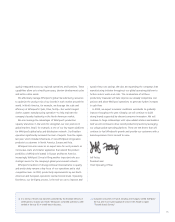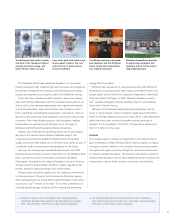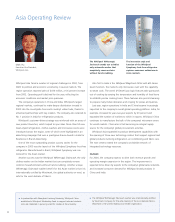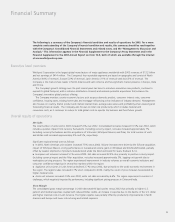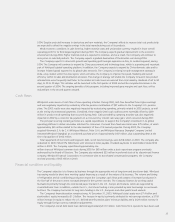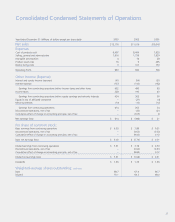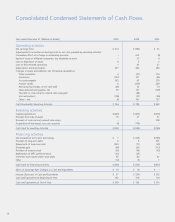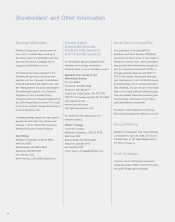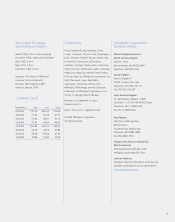Whirlpool 2003 Annual Report Download - page 27
Download and view the complete annual report
Please find page 27 of the 2003 Whirlpool annual report below. You can navigate through the pages in the report by either clicking on the pages listed below, or by using the keyword search tool below to find specific information within the annual report.
25
2004. Despite projected increases in steel prices and raw materials, the Company’s efforts to improve total cost productivity
are expected to offset the negative swings in the total manufacturing cost of its products.
Weak economic conditions in Latin America, higher material costs and unfavorable currency resulted in lower overall
operating profit for its third largest segment during 2003. The Company expects gradual improvement in the economic
environment during 2004. Higher material costs are expected to continue, and as a result, the Company will continue to
raise prices on selected products. The Company expects a gradual devaluation of the Brazilian real during 2004.
The Company expects to drive both growth and operating profit margin expansion in Asia, its smallest segment, during
2004. The Company will continue to expand its China procurement and technology base, which is a growing and important
part of Whirlpool’s global operating platform. In addition, the Company expects to expand its China domestic sales and to
increase finished goods exported to its global sales networks. The Company is revising its trade management strategy in
India, a key market within the Asia region, which will allow the Company to improve the speed, flexibility and overall
efficiency within its sales and distribution processes. This change in strategy will enable the Company to launch new product
introductions more frequently and faster to the market as trade terms are reduced from local industry standards of 60 to 90
days, to 20 to 30 days. This initiative will be launched in the first quarter of 2004 and will be completed sometime in the
second quarter of 2004. The ongoing benefits of this program, including improved gross margins and cash flow, will be
realized late in the second quarter onward.
Cash flows
Whirlpool’s main source of cash flow is from operating activities. During 2003, cash flow benefited from higher earnings
and was negatively impacted by a voluntary after-tax pension contribution of $97 million to the Company’s U.S. pension
plans. The 2003 results were also negatively impacted by restructuring spending, primarily related to 2002 projects, as well
as the timing of promotional payments. Combined, these negative 2003 cash outflows were essentially offset by $239
million in product recall spending that occurred during 2002. Cash provided by operating activities was also negatively
impacted in 2002 by a one-time tax payment on a cross-currency interest rate swap gain, which occurred during 2001.
The principal recurring investing activities are capital expenditures to support the Company’s investment in its global
operating platform to deliver innovative solutions for consumers. Proceeds from fixed asset sales were $75 million, of which
approximately $65 million related to the sale-leaseback of four of its owned properties. During 2002, the Company
acquired Vitromatic S.A. de C.V. (Whirlpool Mexico), Polar (S.A.) and Whirlpool Narcissus Shanghai Company Limited
(renamed Whirlpool Shanghai) at a combined purchase price of approximately $187 million, plus outstanding debt at the
time of acquisition of $162 million.
Total repayments of short-term and long-term debt, net of new borrowings, were $208 million in 2003. The company also
redeemed its $200 million 9% Debentures with short-term notes payable. Dividend payments to stockholders totaled $94
million in 2003. The Company repurchased approximately one
million shares of Whirlpool common stock during 2003 for $65 million under a stock repurchase program previously
authorized by the Board of Directors. The Company also redeemed $33 million in preferred stock of its discontinued finance
company, Whirlpool Financial Corporation. In connection with its stock-based compensation programs, the Company
received proceeds of $65 million in 2003.
Financial condition and liquidity
The Company’s objective is to finance its business through the appropriate mix of long-term and short-term debt. Whirlpool
has varying needs for short-term working capital financing as a result of the nature of its business. The volume and timing
of refrigeration and air conditioning production impact the Company’s cash flows and consists of increased production in
the first half of the year to meet increased demand in the summer months. The Company finances its working capital
fluctuations primarily through the commercial paper markets in the U.S., Europe and Canada, which are supported by
committed bank lines. In addition, outside the U.S., short-term funding is also provided by bank borrowings on uncommit-
ted lines. The Company has access to long-term funding in the U.S., European and other public bond markets.
The Company’s financial position remains strong. At December 31, 2003, Whirlpool’s total assets were $7.4 billion and
stockholders' equity increased to $1.3 billion. The increase in equity is primarily attributed to net earnings retention, a $118
million increase in equity to reduce the U.S. defined benefit pension plans’ minimum liability and a $129 million increase in
equity through foreign currency translation adjustments.
The Company’s overall debt levels have declined approximately $110 million. Cash flows from operations have been used


